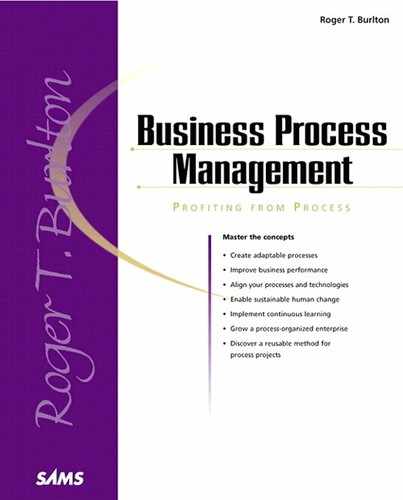Documenting Current Interactions and Health
This step provides a big-picture view of the environment within which products and services are delivered to and from the “Organization-in-Focus.” By looking at the physical items, information, knowledge, and commitments present at the organization’s interface with the outside world, a business can record the nature of the interactions with its external stakeholders. It also can identify the products and services that flow from those interactions and assess the interactions’ health. Through this step, all internal stakeholders can see that there are more views and considerations to be taken into account than just their own. Furthermore, documentation of interactions addresses the fundamental questions “What business are we in?” and “What business should we be in?” The main result is insight into the business from previously overlooked perspectives.
Figure 10.6 shows an example of the knowledge produced as a result of documenting current interactions.
Figure 10.6. Current interactions with stakeholders for Global Software, Inc.

Techniques
The primary methods of documenting interactions aren’t difficult, assuming that the key representatives of the various business areas can be brought together. The techniques are as follows:
Inflow and outflow mapping
Health checks
Workshop management
Lessons Learned
Like some other steps in this phase, interacting with stakeholders is as much art as science. It requires the right, wide range of people in the facilitated session to gain different perspectives and to result in an accepted understanding of what business you are in and need to be in. Start by listing each stakeholder group at the level of detail chosen and then pose the following questions for each group:
What goes to this group from the “Organization-in-Focus”? (outflows)
What comes from them? (inflows)
The questions should include all current and envisioned future items.
Document the definitions of each output or input, obtaining consensus because there is rarely a common language for the terms used. Consider the health of each item listed, relative to how we would like to see its health in the planning timeframe. Mark the item appropriately as in poor, adequate, or good health today. (This relative judgement is based on the participants’ experience and feedback from outside stakeholders.)
Mark each item as being a current and/or future flow, given the group’s insight.
Interaction documentation isn’t about model building, although the deliverable might be in the form of a chart or picture, both of which are good communication tools. It’s more about the process of discussion and consensus regarding the new insights gained.
If possible, use high-touch techniques such as sticky dots to indicate health status (for example, red for poor, yellow for adequate, and green for good health).
